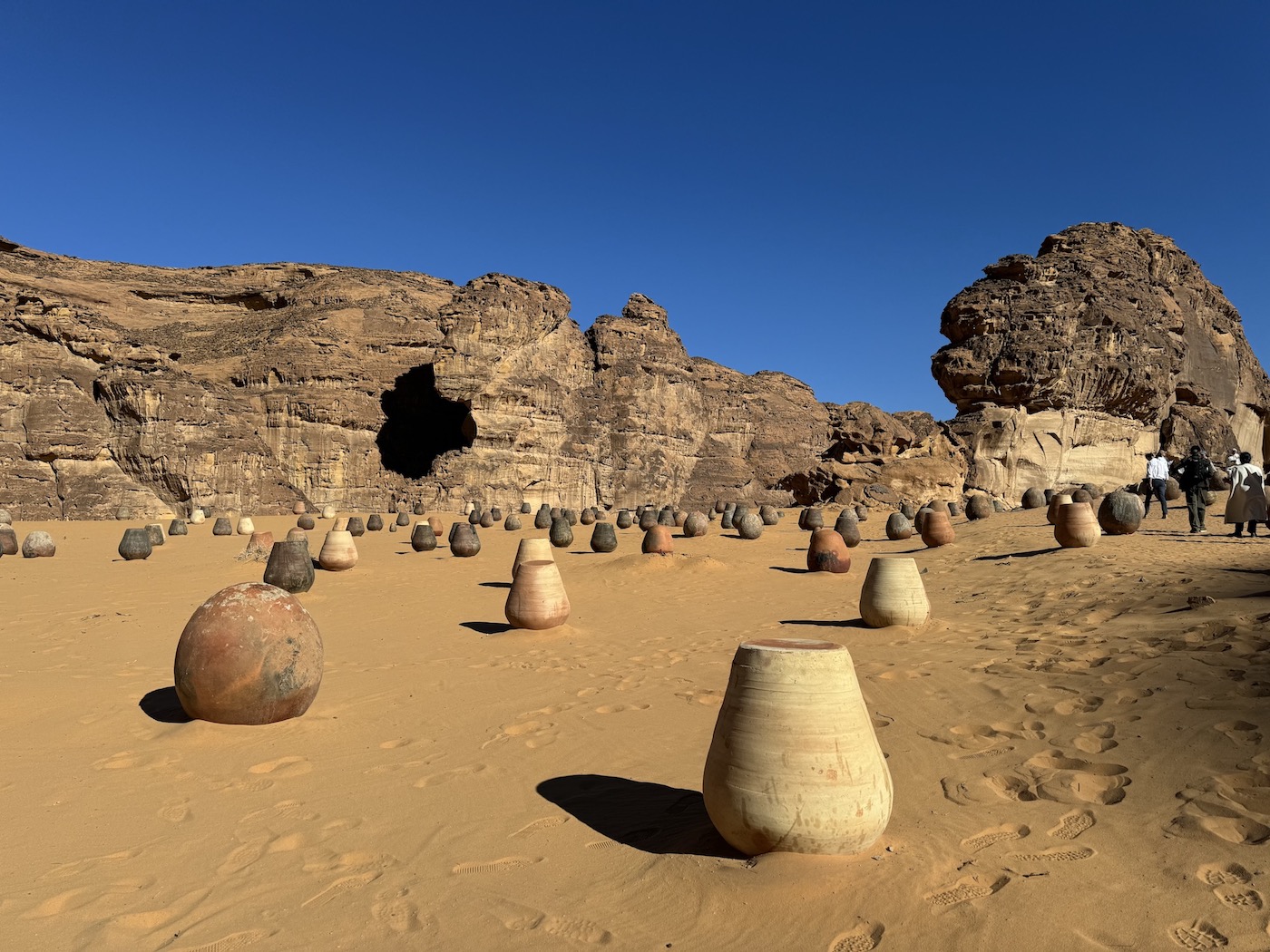Desert X AlUla 2024 – Landing in AlUla is like taking a trip to the moon. The plane flies low over the crater-like rock formations of this magnificent desert, and the sand and stone seem to stretch out forever. It is a different world, which immediately entices and awakens the imagination of anyone who visits.
In this awe-inspiring landscape, the Third Edition of Desert X AlUla, titled In The Presence of Absence and co-curated by Maya El Khalil and Marcello Dantas, invites artists and visitors to contend with the sublime. The artists are challenged to find their distinct ways of representing the human experience of such an ancient yet timeless place, rich with history and teeming with life despite what initially looks like a vast emptiness.

According to co-curator Maya El Khalil, one of the main words cited repeatedly while preparing Desert X was “Respect.” Indeed, it would be difficult not to feel a sense of humility and insignificance in this desert and responsibility in preserving its natural beauty.
Desert X AlUla is very much an immersive experience. The installations are not easy to find, certainly not by foot, but only by the golf carts and four-wheelers accompanying visitors along the way. This is the complete opposite of the “white cube” gallery experience. Here on the leading site, you are directly thrown to the elements, left to contend with the desert, the heat, the wind, and the sand.
One does not feel unwelcome; one simply experiences a heightened awareness of being transitory in an ancient place. The rock formations, shaped by water and wind elements, are enough to mesmerise a visitor.
However, something must be said about the artificial encounters with art at Desert X. They may be synthetic, but no less wondrous. Ibrahim Mahama’s Dung Bara-The Rider Does Not Know The Ground is Hot (Top Photo), one of many excellent titles in the exhibition, makes use of an open, sandy plain, in which a multitude of old terracotta pots are seemingly dropped into the desert, upside down. The Ghanaian artist seeks to represent an element of his country’s history. The significance of the pot as a traditional means to carry food and water can also be found in Saudi Arabia, allowing the artist to find shared histories and dialogue between the two countries. Some of the pots are broken, a nod to human resilience and the ability to break and come back together. Flipping the pots upside down was a deliberate play to allow us to see more details, but also a playful choice as the pots could be seen as dragon eggs, tapping into the mysticism of the desert landscape.

The variety of ways the artists responded to the landscape echoes the plurality of the desert. It is a haunting place that plays with the imagination at every turn. It is not difficult to see why so many stories and myths are set within it. In conversation with co-curator Maya El Khalil, we discussed the unique way in which Filwa Nazer tapped into the mythology of the desert with her emotional response to the landscape in Preserving Shadows or how Rand Abdul Jabbar treats the celestial realm in Where Myths are Born of Mud and Desire.

Some highlights were those installations that felt like an ancient civilisation that might have been responsible for leaving their mark behind. They echo the ancient carvings of nearby Hegra, where traces of the Nabataeans, an ancient Arab people, remain etched in the stone.

The best example is Sara Alissa and Nojoud Alsudairi’s Invisible Possibilities: When the Earth Began to Look at Itself. A gentle downward slope leading into an artificial trench in the sand with carved steps leading out on either side is almost easy to miss until you are in the belly of the desert. It fits seamlessly into the landscape, as though it always existed. Although requiring some physical intervention, it uses what is already available within the landscape. The artwork brings to life what is already there and harnesses the elements to create a cooling effect once you are below the sand level. Architectural non-intervention and using found materials pave the way for how projects in AlUla can be approached.

The magic of Desert X also lies in the element of discovery. That is why many of those more spread out or hidden artworks feel special. For instance, hidden between the rocks, Kader Attia’s Whistleblower is a happy surprise. As the wind passes through the deep blue glass installations, a series of structures of bottles melt together, making a whistling sound. This delightful artwork plays on the senses and was inspired by the artist’s experience of hearing the wind pass through a bottle he was carrying while walking in the desert. The installation creates a dialogue between nature, art, and the people witnessing it through the stillness required to hear the wind pass through. It is a story of what was, what is, and what is yet to come.
In collaboration with the Royal Commission for AlUla, this edition of Desert X feels like a tipping point into a rapidly changing future. With multiple projects centred around arts and culture already underway, the richness of possibility can be felt everywhere.
Saudi Arabia’s face is firmly turned towards the future and the outside world while honouring its well-established art scene and rich cultural history.
With its vastness and carefully curated works, Desert X is an invitation to pause and reflect on what will come without losing sight of the past. It reminds us of art’s power to express what can’t be said while inspiring critical reflection in a rapidly changing world.
Top Photo: Ibrahim Mahama, Dung Bara- The Rider Does Not Know the Ground Is Hot Photo: Leila Lebreton © Artlyst 2024

